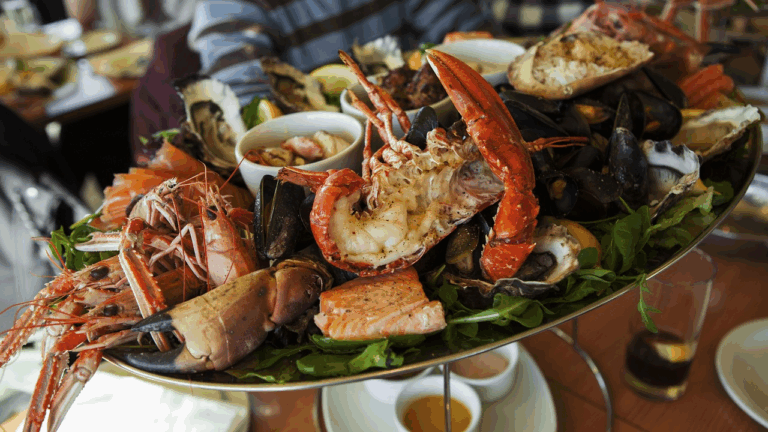The Complete Guide to Seafood Benefits and Side Effects

Key Summary: High-quality protein, important omega-3 fatty acids, and essential nutrients like vitamin D, iodine, and selenium are just a few of the remarkable health benefits that seafood provides. But there are also possible hazards like allergies, mercury poisoning, and environmental issues like overfishing. You can enjoy seafood safely by selecting sustainably sourced, low-mercury seafood and using safe handling techniques. With the help of this guide, you can make well-informed and sustainable seafood consumption decisions. |
A growing number of people are choosing seafood as a primary source of nutrients due to the current health consciousness. But despite the benefits of lean protein and omega-3s, there are also unspoken risks like allergies, mercury pollution, and unsustainable harvesting. Only when you try to reconcile conflicting advice about which fish to eat, how frequently to eat them, and whether farmed seafood is as harmful as claimed does it become confusing. What seemed like a healthy choice becomes a diet conundrum when environmental sustainability concerns are added.
This comprehensive guide will explain the real advantages and potential drawbacks of eating seafood. You’ll discover the keys to choosing safe, fresh, and sustainable seafood, steering clear of pitfalls, and also learn about the rich cultural heritage of seafood.
Table of Contents
Nutritional Benefits of Seafood
Seafood has a lot of nutrients. In contrast to other protein sources, seafood can be high in lean, high-quality protein as well as the essential omega-3 fatty acids EPA and DHA. It has been demonstrated that these nutrients improve mood, lower inflammation, improve mental function, and support cardiovascular health. The Harvard T.H. Chan School of Public Health claims that eating seafood lowers the risk of heart disease, stroke, and mental decline.
In addition to omega-3s, seafood is rich in iodine, which is vital for metabolism and brain development, selenium, which supports thyroid and immune function, and vitamins D and B12. Iron and zinc, which are essential for the production of red blood cells and immune system function, are abundant in shellfish, especially clams and oysters.
- Omega-3 fatty acids improve neurological and cardiovascular health.
- Protein is necessary for both muscle growth and repair.
- Vitamin D improves immunological response and calcium absorption.
- Thyroid and metabolic function are enhanced by iodine and selenium.
- effects that reduce inflammation aid in the management of chronic conditions
The Nutritious Character of Typical Seafood
| Seafood Type | Calories (100g) | Omega-3s (mg) | Protein (g) | Mercury Level |
|---|---|---|---|---|
| Salmon | 206 | 2,260 | 22 | Low |
| Tuna | 132 | 300 | 28 | High |
| Shrimp | 99 | 540 | 24 | Low |
| Cod | 82 | 195 | 18 | Low |
| Mackerel | 205 | 2,700 | 20 | Moderate |
Seafood Types and Their Advantages
A wide range of nutritional benefits are made possible by the diversity of seafood. Choosing a variety of fish and shellfish helps avoid nutritional gaps because each type has a different nutritional value.
For instance, salmon is a great source of omega-3 fatty acids and vitamin D. Due to their small size and edible bones, sardines are high in calcium. Despite being high in protein and lean, tuna should only be eaten in moderation due to its mercury content. Copper, zinc, and trace minerals are found in shellfish such as shrimp and mussels.

Regional differences also exist in seafood culture. For example, Seafood Traditions Meet Morgantown explores how fresh seafood and traditional Appalachian cooking methods combine to create a dish that reflects cultural diversity.
Top Picks:
- Salmon: Omega-3 fatty acids, vitamin
- Tuna: High protein, moderate mercury content
- Sardines: Calcium and omega-3 rich
- Oysters: A rich source of zinc and iron
- Shrimp: Low-calorie, rich in selenium
- Mussels: Sustainable, iron-rich, omega-3s
Typical Adverse Reactions and Health Hazards
Seafood is not always risk-free. Mercury poisoning can result from excessive consumption of some species, particularly in susceptible groups like children and pregnant women. Fish with high mercury levels, such as shark, swordfish, king mackerel, and tilefish, should be avoided by those groups, the FDA says.
Another worry is foodborne illnesses. Seafood that has been contaminated or improperly stored can lead to nausea, vomiting, and in severe cases, serious infections from bacteria like Vibrio. Allergies, particularly to shellfish, are another problem.
According to Seafood and Sustainability: How Fish Frenzy Supports the Environment in Beckley, initiatives are being made in areas like Beckley to address these issues through sustainability and education.
Possible adverse effects
- Mercury poisoning can cause neurological damage and cognitive problems.
- Bacterial infections brought on by careless handling
- Shellfish allergies
- Problems with digestion caused by spoiled seafood
- Excessive sodium intake from processed fish
Mercury and Environmental Contaminants
Mercury is a heavy metal that accumulates in fish through pollution. Larger predatory fish tend to carry higher levels due to bioaccumulation. Mercury affects the nervous system and can cause developmental issues in unborn children.
Other contaminants include PCBs and dioxins, especially in farm-raised fish from polluted waters. Choosing fish lower on the food chain (like sardines and trout) and those from clean sources reduces your risk.

Refer to the EPA’s guidelines on mercury for details on safe consumption.
Low-Mercury Seafood:
- Salmon
- Cod
- Trout
- Haddock
- Sardines
Seafood Allergies and Sensitivities
Shellfish allergies are common and can develop at any stage of life. Reactions range from mild (hives, digestive discomfort) to severe (anaphylaxis). Shellfish include crustaceans (shrimp, crab, lobster) and mollusks (clams, oysters, mussels).
Cross-contamination is a significant concern when dining out. Individuals with allergies should carry an epinephrine injector and avoid ambiguous menu items.
Symptoms of Seafood Allergies:
- Swelling of lips or throat
- Difficulty breathing
- Rash or hives
- Nausea or vomiting
- Anaphylaxis
Your Guide to Safe Seafood Consumption
To obtain the best from seafood, it needs to be stored and prepared properly. Cook seafood to an internal temperature of 145 degrees Fahrenheit, and store fresh seafood at 32 degrees Fahrenheit and below.
Purchase from trusted dealers and inspect for signs of freshness such as clear eyes, firm flesh, and a mild ocean aroma. Do not purchase fish with a strong odor or mushy texture.
Use Seafood Watch for recommendations for safe and sustainable seafood purchasing.
Safe Handling Tips
- Cook thoroughly to destroy bacteria and parasites
- Store properly (use within 2 days after purchase)
- Avoid raw seafood except from reliable sources
- Verify origin and certification marks
- Switch seafood species to reduce contact with harmful contaminants
Selecting Fresh and Sustainable Seafood
Sustainability and freshness go hand in hand. Fresh seafood must be shiny, smelling salty but never fishy, and kept iced. Sustainable seafood is caught using well-governed fisheries or environmentally friendly aquaculture.
Purchasing Options
- Search for clear eyes, firm flesh
- Inquire source and harvest method
- Buy local and seasonal whenever possible
- Check for MSC, ASC certification
- Avoid overfishing or endangering species
The Problem of Overfishing
Fish stocks and marine ecosystem health are being threatened by overfishing, a widespread issue globally. Declines and reduced biodiversity occur when fish are being caught more rapidly than they can reproduce. The Food and Agriculture Organization (FAO) indicates that more than 34% of the world’s fisheries are overfished. Bottom trawling and other techniques destroy habitats on the sea floor, and the situation is compounded by bycatch, which takes non-target species unintentionally. Coastal communities lose economically, disturb marine food chains, and threaten food security if immediate action is not taken.
Negative Impacts of Overfishing:
- Fish Population Decline: Stocks of key species like tuna and cod are shrinking.
- Ecosystem Damage: Trawling and unsustainable methods harm coral reefs and marine habitats.
- Loss of Biodiversity: Affects entire food webs and the resilience of ocean life.
- Bycatch Waste: Non-target species such as dolphins, sea turtles, and juvenile fish are killed unnecessarily.
- Food Insecurity: Millions rely on fish as a primary protein source.
- Economic Decline: Fishing communities lose income and jobs as stocks collapse.
Sustainable Seafood Solutions:
- Support Catch Limits: Science-based quotas help maintain healthy fish populations.
- Buy Responsibly: Choose fish from sustainable sources with eco-labels like MSC.
- Diversify Your Diet: Eating less popular, fast-growing species eases pressure on overfished stocks.
- Respect Fishing Seasons: Seasonal closures allow fish time to spawn and regenerate.
- Advocate for Marine Protected Areas: MPAs allow ecosystems to recover naturally.
- Stay Informed: Use tools and guides to make conscious, ocean-friendly choices.
Frequently Asked Questions
Is seafood safe to eat daily?
Moderate consumption (2–3 times weekly) is best. Vary your seafood types.
What are the effects of eating seafood?
Fish and shellfish are healthy foods. They are high in protein and low in saturated fat. They have nutrients that are important for proper growth and development. Studies show that omega-3 fatty acids in fish may reduce the risk of heart disease and stroke
What are the benefits of seafood?
Packed with omega-3 fatty acids, seafood is a powerhouse for heart health, cognitive function, and joint flexibility. Additionally, it boasts an abundance of essential minerals like iodine, selenium, and zinc, crucial for supporting thyroid function and our immune system.
Which seafood is best for health?
Salmon. And as a canned fish, it generally has less mercury than tuna. Wild salmon caught in Alaska is a good source, whether fresh or canned. Because fatty fish like salmon can have more of the banned chemicals called PCBs, it helps if you cut away or drain the extra fat, skin, and darker meat
Final Thoughts
Seafood is one of the most nutrient-dense foods you can add to your plate when chosen and prepared with care. Whether you’re enjoying a dish at Local seafood restaurants in Morgantown or looking to order fresh seafood online, informed choices help you reap the rewards while minimizing risk. For an even better experience, consider exploring good fish restaurants that emphasize sustainability and seasonality.
References
1. Harvard T.H. Chan School of Public Health – Fish https://nutritionsource.hsph.harvard.edu/fish/
2. EPA – Mercury https://www.epa.gov/mercury
3. Seafood Watch Guide https://www.seafoodwatch.org/
4. FAO Report on Overfishing https://www.fao.org/publications/sofia/en/
